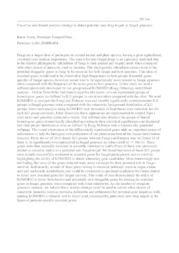Use of an enrichment analysis strategy to detect potential new drug targets in fungal genomes.
Use of an enrichment analysis strategy to detect potential new drug targets in fungal genomes.
Author(s): SOUZA, R.; LOBO, F. P.
Summary: Fungi are a major class of pathogens in several animal and plant species, having a great agricultural, veterinary and medical importance. The search for anti-fungal drugs is an especially hard task due to the relative phylogenetic relatedness of fungi to their animal and vegetal hosts when compared with other classes of parasites, such as bacteria. This phylogenetic relatedness causes most of the potential druggable genes in fungi to be essential for both fungal and host genomes. This class of essential genes would tend to be observed at high frequencies in both groups. Essential genes specific of fungal species, however, would tend to be significantly more present in fungal genomes when compared with the frequency of the same gene in host genomes. In this study we used a software previously developed by our group named KOMODO (Kegg Orthology enrichMent analysis ? Online DetectiOn) that detects significantly under- or over-represented groups of homologous genes (as defined by KO groups) in one taxon when compared with the other. We used KOMODO to compare the Fungi and Eukarya taxa and identify significantly overrepresented KO groups in fungal genomes when compared with the eukaryotic background distribution of KO groups. Since each analysis using KOMODO tests thousands of hypotheses (one statistical test for each KO group surveyed), False Discovery Ratio approaches are implemented to control Type I error ratios and generate corrected q-values. Our software also displays the groups of biased homologous genes hierarchically classified according to their statistical significance and displayed into their proper biochemical roles as defined by Kegg Pathways into a dynamically generated webpage. The visual observation of the differentially represented genes adds an important source of information to help the biological comprehension of the phenomena behind the biased distributions detected. From the set of 2611 shared KO groups between Fungi and Eukarya taxa we found 88 of them to be significantly overrepresented in fungal genomes (q-value cutoff of <= 10e-5). These genes were then manually surveyed in scientific literature to verify if any of them was previously studied as essential and/or as a potential anti-fungal target. We found that some of these KO groups were already successfully evaluated as essential genes for fungal pathogenesis and/or survival, highlighting the ability of KOMODO to detect interesting gene candidates. More interestingly was the finding that most of the genes detected were never surveyed for their potential role in fungal survival. Additionally, several of these genes belong to essential pathways (such as sugar, amino acid and nucleotide metabolism), and could be considered as potential candidates for future studies to detect new essential genes for fungal survival. This study of case demonstrated the utility of KOMODO to detect both known and potentially new druggable genes by looking for enriched genes in fungal genomes when compared with other eukaryotes. As the number of complete genomes increase, we believe that a similar strategy could be used to survey other classes of eukaryotic parasites (such as protozoa, helminths and arthropods) for potential gene targets as well, making KOMODO a valuable tool to detect (and, consequently, prioritize) new drug targets in the figure of parasite-specific essential genes.
Publication year: 2011
Types of publication: Abstract in annals or event proceedings
Keywords: Fungi, Genoma de fungos, Genome, Software, Software KOMODO
Observation
Some of Embrapa's publications are published as ePub files. To read them, use or download one of the following free software options to your computer or mobile device. Android: Google Play Books; IOS: iBooks; Windows and Linux: Calibre.
Access other publications
Access the Agricultural Research Database (BDPA) to consult Embrapa's full library collection and records.
Visit Embrapa Bookstore to purchase books and other publications sold by Embrapa.

